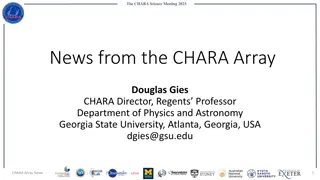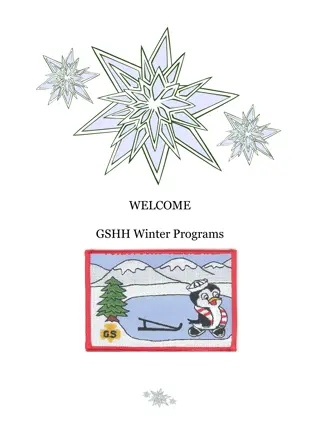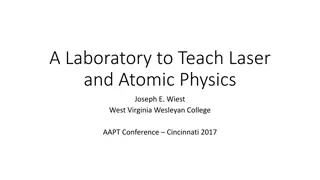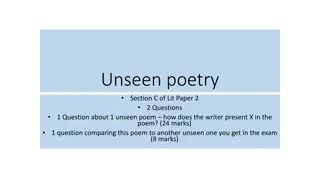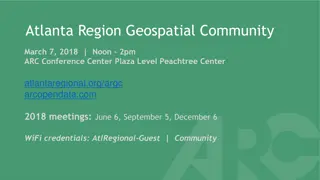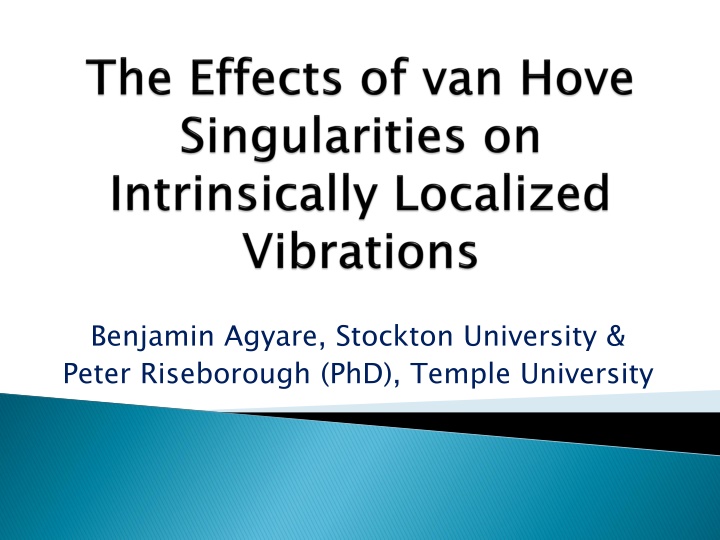
Investigating Vibrations in NaI Lattice for Potential ILM Formation
Explore the behaviors of lattice vibrations in NaI, focusing on van-Hove singularities and potential formation of Interstitial Lattice Modes (ILMs). Investigate one-phonon and two-phonon density of states to identify coalescing q vectors and examine anharmonic interactions. Model the lattice with isotropic harmonic forces and explore the equation of motion to understand lattice dynamics.
Download Presentation

Please find below an Image/Link to download the presentation.
The content on the website is provided AS IS for your information and personal use only. It may not be sold, licensed, or shared on other websites without obtaining consent from the author. If you encounter any issues during the download, it is possible that the publisher has removed the file from their server.
You are allowed to download the files provided on this website for personal or commercial use, subject to the condition that they are used lawfully. All files are the property of their respective owners.
The content on the website is provided AS IS for your information and personal use only. It may not be sold, licensed, or shared on other websites without obtaining consent from the author.
E N D
Presentation Transcript
Benjamin Agyare, Stockton University & Peter Riseborough (PhD), Temple University
ILMs are persistent vibrations of atoms in a homogeneous lattice which extend only over a finite region of space. It s been reported that these vibrations can be found in NaI, but only exist for wave- vectors at the corner of the 3-D Brillouin Zone. It has been suggested that ILMs occur whenever the van-Hove singularities of the two phonon density of states coalesce at the upper-edge of the continuum.
Objectives: 1. To investigate the one-phonon & two- phonon density of states of NaI and examine its van-Hove singularities in order to identify at which q vectors they may coalesce. 2. To introduce anharmonic interactions and determine if they are enhanced by the van-Hove leading to the formation of ILMS.
Modeled by coupling the atoms located at the lattice sites equivalent to (0,0,0) for I atoms (mass MA = 127) to the Na atoms (of mass MB =23) located at the nearest-neighbor sites ? isotropic harmonic forces. Lattice parameter a a is equal to 6.47 Angstroms. I 21,1,1 by Na + + = =
The primitive lattice vectors are given by ?1=? The volume of the primitive unit cell is = ?1 ?2 ?3 = ?3 The reciprocal lattice vectors are ?1= ? ?2= ? 2? ? Volume of the Brillouin zone of primitive cell is 4 ? 20,1,1 , ?2=? 21,0,1 , ?3=? 21,1,0 4 z 2? 1,1,1 , 2? 1, 1,1 , and ?? ?3= 1,1, 1 ?? y a3 3 3 2? x
Equation of motion, for ? = ????: ? ? Assume ?? ? in equation of motion, we have ? ? ?,? ? ?, ? and substitute = ? ,? ???,???? ?? ?? ?? ???? ? ???+?? ?? ? 1 = ? ??? and ?2??? = ???? The secular determinant ?,? ? ?2?????,? ?,?? ?? ?? ? ?,?2= ??? ?,? ? ? 1 ? ???? where ??? = ? ?,?
? ?,?2 is equal to ?? ?? ?? 0 ?? ???2 ?? ?2,? ?2,? ?1,? ?2,? ?2,? ?1,? 0 0 ?2,? 0 0 ?? ?1,? 0 ?2,? ?? ?? ?? ???2 ?? ?? ?1,? ?2,? ?? ?? ?? ???2 ?? ?? ?2,? 0 ?1,? 0 ?? ???2 ?? ?? ?? 0 0 ?? ?? ?? ???2 ?? ?2,? ?2,? ?2,? ?2,? ?? 0 0 ?? ?? ?? ?? ???2 ?? ?1,? The force constant which couple the lattice displacement of atoms with the same sub lattice indices can be expressed as
??? 2+ cos??? cos??? ??= 2?1+ 2?22 cos??? ?? cos 2 2 ??? 2 2+ cos??? cos??? 2+ cos ??= 2?1+ 2?22 cos ?? 2 ??? 2 ??= 2?1+ 2?22 cos??? ?? 2 Then matrix elements involving the nearest neighbor force constants ?1 which couple A and B displacement are given by ??= 2?1cos??? Then matrix elements involving the next-nearest neighbor force constants ?2 which couple the different components of displacement of atoms on the same sub-lattice are given by ??= 2?1sin??? ?2,? 2 ??? 2, ?1,? ??= 2?1cos??? 2, ?1,? ??= 2?1cos ?1,? 2 ??? 2, ??? 2sin??? ??= 2?1sin??? 2sin??? 2, ?2,? 2sin ?2,? ??= 2?1sin
The one phonon density of state is ?=?3 4 2+? The two phonon density of state is written as ?3? 2?3? ? ?? ? ?? ?3? 2?3? ? ?? ?,?=?3 ? ? ?? ?? 4 2+? 2 ? The integration over delta function is turned into a surface of constant energy ?=?3 4 2?3 ???? 2+? ? ?,?=?3 4 2?3 ???? 2+? 2 ? ? ?2?? 1 ? ?? ?2?? 1 ?? ? ? + ?? Van-Hove singularity occurs ?? ?? =0 or ?? ?? =0 ? ? ? + ?? 2+? 2+? 2 ?
One Phonon DOS. Optic mode ratio K2/K1 = 0.598, -> 0.003. Acoustic One Phonon DOS mode ratio K2/K1 = 0.202, -> 0.001. Approx. area under each curve = 6 sq. units 50 45 40 ( ) arb units 35 30 25 20 15 10 5 0 0.000 0.050 0.100 0.150 0.200 0.250 0.300 0.350 0.400 0.450 0.500 0.550 0.600 Optic Mode Ratio Acoustic Mode Ratio
Two Phonon DOS. Approx. Area = 36 Sq. Units 350 300 250 ( ) arb units 200 150 100 50 0 0.00 0.10 0.20 0.30 0.40 0.50 0.60 0.70 0.80 0.90 1.00 1.10 1.20 Optic Mode Ratio Acoustic Mode Ratio
DOS graph of () vs for optic mode ratio K2/K1 = 0.598, constructed from surface of constant energy integral. :(0,0,0), L: ( L: ( / /a, a, / /a, a, / /a) a) , X:(0, 2 /a, 0) 80 75 70 ( ) arb units 65 60 55 50 45 40 35 30 25 20 15 10 5 0 0.00 0.05 0.10 0.15 0.20 0.25 0.30 0.35 0.40 0.45 0.50 0.55 0.60 0.65 0.70 0.75 0.80 0.85 0.90 0.95 1.00 1.05 1.10 1.15 1.20
DOS graph of () vs for optics ratio K2/K1 = 0.598, constructed from delta function with =0.003. q = (0,0,0), q = L( /a, /a, /a), q = U( /2a, 2 /a, /2a) 70 60 ( ) arb units 50 40 30 20 10 0 0.000 0.100 0.200 0.300 0.400 0.500 0.600 0.700 0.800 0.900 1.000 1.100 1.200
Summary: 1. The one-phonon and two-phonon density of states exhibits features at the van Hove singularities at fixed frequencies, but the spectral features are not divergent due to the 3-D nature of the crystal. 2. For different q values, several van Hove singularities converge at one frequency and produce a large peak in the two-phonon DOS. 3. Next: search for q values at which the two- phonon density of states is enhanced and then examine whether the introduction of anharmonic interactions can bind the two- phonon excitations to produce a quantized ILM.
[1]. A. J. Sievers, S. Takeno, Phys. Rev. Lett. 61, 970 (1988). [2] W.Z. Wang, J.T. Gammel, A.R. Bishop and M.I. Salkola, Phys. Rev. Lett. 76, 3598-3601 (1996) [3] L. Proville, Phys. Rev. B, 71, 104306 (2005). [4] ME Manley AJ Sievers & JW Lynn, Phy. Rev B 79 134304 (2009) [5] D. Kanbur & P.S. Riseborough, Phil. Mag. Letts 94, 424 432 (2014)



